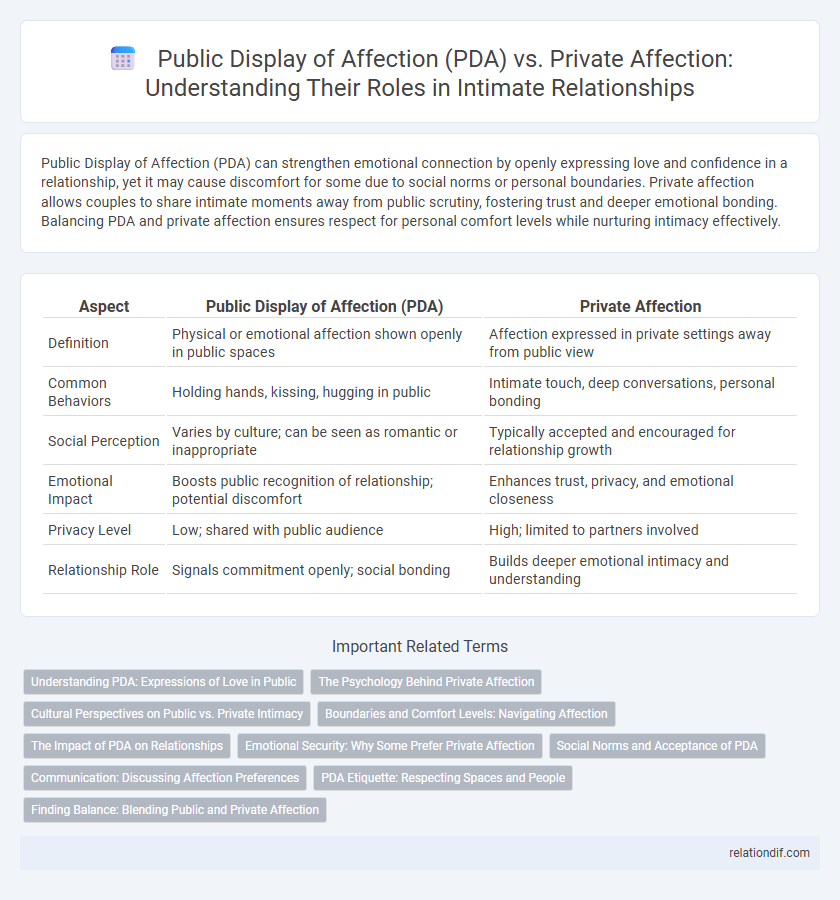Public Display of Affection (PDA) can strengthen emotional connection by openly expressing love and confidence in a relationship, yet it may cause discomfort for some due to social norms or personal boundaries. Private affection allows couples to share intimate moments away from public scrutiny, fostering trust and deeper emotional bonding. Balancing PDA and private affection ensures respect for personal comfort levels while nurturing intimacy effectively.
Table of Comparison
| Aspect | Public Display of Affection (PDA) | Private Affection |
|---|---|---|
| Definition | Physical or emotional affection shown openly in public spaces | Affection expressed in private settings away from public view |
| Common Behaviors | Holding hands, kissing, hugging in public | Intimate touch, deep conversations, personal bonding |
| Social Perception | Varies by culture; can be seen as romantic or inappropriate | Typically accepted and encouraged for relationship growth |
| Emotional Impact | Boosts public recognition of relationship; potential discomfort | Enhances trust, privacy, and emotional closeness |
| Privacy Level | Low; shared with public audience | High; limited to partners involved |
| Relationship Role | Signals commitment openly; social bonding | Builds deeper emotional intimacy and understanding |
Understanding PDA: Expressions of Love in Public
Public display of affection (PDA) serves as a visible expression of love, signaling emotional connection and reinforcing relationship bonds in social settings. Understanding PDA involves recognizing cultural norms, personal boundaries, and mutual comfort levels that influence how affection is conveyed publicly. Balancing PDA with private affection allows couples to nurture intimacy while respecting social etiquette and individual preferences.
The Psychology Behind Private Affection
Private affection fosters a deep sense of security and emotional intimacy, activating oxytocin release that strengthens bonding between partners. Psychological studies reveal that individuals who prefer private displays of affection often value trust and vulnerability, enhancing relationship satisfaction and reducing anxiety. Unlike public displays, private affection allows couples to express genuine emotions without social judgment, promoting healthier and more resilient connections.
Cultural Perspectives on Public vs. Private Intimacy
Cultural perspectives on public display of affection (PDA) vary widely, with some societies embracing open expressions of intimacy as a norm, while others regard them as inappropriate or disrespectful. In many Western cultures, brief gestures like holding hands or light kissing in public are generally accepted and seen as symbols of affection, whereas in conservative societies such as parts of the Middle East and Asia, such behaviors are typically reserved for private settings to maintain social decorum. These differing cultural norms influence how couples navigate expressions of love, balancing personal desires with societal expectations regarding public versus private intimacy.
Boundaries and Comfort Levels: Navigating Affection
Public Display of Affection (PDA) and private affection require clear boundaries to respect personal comfort levels and social norms. Couples should communicate openly about their preferences to ensure mutual comfort and avoid discomfort or misunderstandings in different environments. Understanding cultural context and individual sensitivities is essential for navigating intimacy without compromising respect or emotional safety.
The Impact of PDA on Relationships
Public Display of Affection (PDA) can strengthen relationships by enhancing emotional bonding and increasing feelings of security when partners feel comfortable expressing love openly. However, excessive or inappropriate PDA may lead to discomfort or social disapproval, potentially causing strain between partners and affecting relationship satisfaction. Balancing private affection with respectful public interactions often fosters trust and deeper intimacy, supporting long-term relationship stability.
Emotional Security: Why Some Prefer Private Affection
Private affection fosters emotional security by creating a safe, intimate space where partners can express vulnerability without fear of judgment or external scrutiny. This environment allows for deeper emotional connection and trust, which can be compromised during public displays of affection due to social anxiety or cultural taboos. Psychological studies indicate that couples prioritizing private affection often report higher relationship satisfaction and emotional resilience.
Social Norms and Acceptance of PDA
Public Display of Affection (PDA) varies widely across cultures, with social norms dictating its acceptance in different societies. In more liberal environments, PDA is often seen as a natural expression of intimacy, while in conservative or traditional settings, it may be discouraged or even taboo. Understanding these cultural differences is crucial for respecting local customs and avoiding social discomfort.
Communication: Discussing Affection Preferences
Discussing affection preferences between Public Display of Affection (PDA) and private affection enhances emotional understanding and relationship satisfaction. Couples who openly communicate boundaries regarding PDA create a respectful environment that honors individual comfort levels and cultural norms. Effective communication fosters trust, ensuring both partners feel valued and connected regardless of the setting.
PDA Etiquette: Respecting Spaces and People
Public Display of Affection (PDA) requires mindful etiquette to balance expressing intimacy while respecting communal spaces and diverse comfort levels. Understanding social norms and observing consent within public settings ensures that affectionate gestures enhance connection without causing discomfort or intrusion. Prioritizing situational awareness and sensitivity promotes respectful interactions that honor both partners and bystanders.
Finding Balance: Blending Public and Private Affection
Balancing public display of affection (PDA) and private affection is essential for nurturing healthy intimacy within relationships, as each context influences emotional connection differently. Public affection, such as holding hands or brief kisses, can reinforce social bonds and signal commitment, while private moments foster deeper vulnerability and trust. Striking a mindful balance respects personal boundaries and cultural norms, enhancing overall relationship satisfaction and emotional security.
Public Display of Affection (PDA) vs Private Affection Infographic

 relationdif.com
relationdif.com